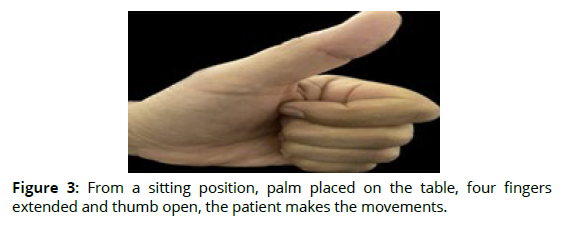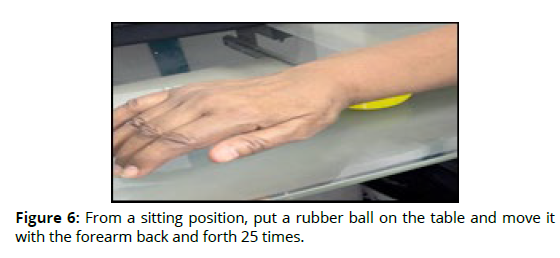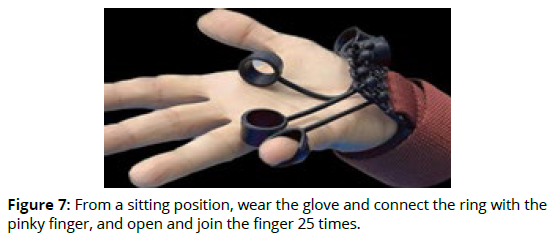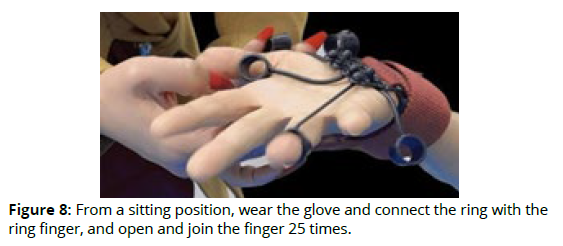Full Length Research Article - (2023) Volume 18, Issue 2
The Effect of Rehabilitative Exercises Preceded by the Electrical Nerve Stimulation Device in Relieving Pain and Rehabilitating People with De Quervain Syndrome
Basma Khalid Hasan1* and Suaad Abdulhussein2*Correspondence: Basma Khalid Hasan, College of Physical Education and Sport Sciences for Women, University of Baghdad, Iraq, Email:
Abstract
Rehabilitation and treatment of injuries is of high importance in returning the injured part to its normal position through rehabilitative exercises. The exercises should be based on mechanical and anatomical physiology through the physical and diagnostic test for each individual separately. Therefore, rehabilitation is a means of treating various injuries by using electrical stimulation of the nerve. For this aim, the researcher prepared rehabilitative exercises preceded by the use of electrical stimulation of the nerve in the rehabilitation of de Quervain syndrome. Through the researcher's access to many references and her visit to many treatment centers, she found that all rehabilitation programs are based on the repetition of certain exercises; therefore, the researcher decided to develop solutions to this problem. The researcher hypothesized that there are differences between the pre and post tests. The researcher further applied the exercises on a sample of (5) patients. The research concluded that the exercises preceded by the stimulation device in rehabilitating the de Quervain syndrome are effective, and recommended adopting the rehabilitative approach to physiotherapy centers.
Keywords
Rehabilitative exercises, Nerve stimulation, Relieving pain, Rehabilitating people, De quervain syndrome.
Introduction
Rehabilitation and treatment of injuries is of high importance in returning the injured part to its normal position through rehabilitative exercises. The exercises should be based on mechanical and anatomical physiology through the physical test and diagnosis for each individual separately. Therefore, rehabilitation is a means of treating various injuries, as it helps to increase the rate of healing of muscle tissues, ligaments, bones, and helps to speed up the drainage of clusters and accumulations. It also works to restore the functions of affected muscles and joints in the shortest possible time, and to restore the physical and functional efficiency of the injured part. It is important for the body to carry out the process of repairing and regenerating tissues, whether in bones or ligaments, reducing pain and improving movement. It is effective in treating and relieving pain and enhancing the factors that lead to repairing injured the tissues. The nerve stimulator device stimulates nerves and improves blood circulation for people with De Quervain syndrome as well as relieving the pain. Ignoring this injury and failing to treat it early leads to its exacerbation. Hence, the researcher decided to provide rehabilitative exercises preceded by the electrical stimulation device in relieving pain and rehabilitating people with de Quervain syndrome [1-5].
Research problem
De Quervain syndrome is one of the conditions that occur among professionals as a result of using wrist directly or indirectly through activities, movements and household chores. Based on the aforementioned concepts, and after the researcher looked at many physiotherapy centers, she found that many women suffer from this condition. Not to mention the absence of elaborate rehabilitation programs, and contentment with several simple repetitive exercises by the therapist without following an elaborate curriculum with respect to frequency, rest times and groups. Therefore, the researcher decided to study this problem and develop solutions to it through preparing elaborate exercises according to the opinions of experts, preceded by the electrical stimulation device, with the aim of relieving pain and rehabilitating women with de Quervain syndrome [6-8].
Research objectives
• Preparing rehabilitative exercises preceded by the electrical stimulation device for the nerve in relieving pain and rehabilitating women with de Quervain syndrome.
• Identifying the effect of the exercises preceded by the electrical stimulation device for the nerve in relieving pain and rehabilitating women with de Quervain syndrome.
Research hypotheses
• There are statistically significant differences in pain relief for patients with De Quervain syndrome.
• There are statistically significant differences in the rehabilitation of women with de Quervain syndrome.
Research limitations
• The human limitation: a sample of (5) women diagnosed with de Quervain syndrome.
• The temporal limitation: the period from (01.09.2022) to (01.11.2022).
• The spatial limitation: in the International Center for Physiotherapy, the physiotherapy hall.
Definition of terms
De Quervain syndrome: It is an inflammation of the two tendons that control the movement of the thumb and their sheaths, which results in pain outside the wrist, usually with increasing pain when gripping or rotating the wrist. It may also be difficult to move the thumb smoothly. In this case, symptoms appear gradually [9-11].
Research Methodology
Method is "the method that the individual produces in order to reach a specific goal" (19:1). Therefore, the researcher used the experimental method as it is appropriate with the research problem.
Research sample
The process of selecting the research sample is one of the most important problems facing the researcher in completing the research as the results of the research depend on the samples. In addition to being one of the important stages of the research. Therefore, the researcher must consider the sample upon defining the problem (95:2 )".
The researcher conducted a survey on physiotherapy centers identify instances of de Quervain syndrome. The researcher found a sample of women with de Quervain syndrome in the International Center for Physiotherapy, after they were diagnosed by the specialist doctor [1].
The degree of condition was determined in the physiotherapy center in the International Center as medium, and the researcher selected (5) of them who did not exercise sports. The criterion on which the researcher based her selection is the fact that those women volunteered to complete rehabilitation as well as the proximity of the center to their residence [12-14].
Methods and Devices Used in the Research
• Arabic and foreign references and sources.
• Personal interviews.
• Measurements and tests
• The internet.
• Visual analogue scale form to determine the degree of pain.
• Rehabilitation exercises.
• Assistant work team.
• Grip strength device.
• Kinovea program (to measure the range of motion).
• Dynamometer to measure the strength of the muscles working on the joint.
• Device to improve grip strength.
• Small rubber balls.
• Latex rubber.
Tests Used in the Research
1. Grip Strength Test (147:3)
• The purpose of the test: to measure the grip strength of the hand.
• Method of registration: the examinee fills the registration form of the reading on the device board and is given two attempts to calculate the best.
2. Muscular strength test with dynamometer (4:72)
• The purpose of the test: measuring the muscles working on the wrist joint.
• Registration method: the examinee is registered on the registration form on the device board and is given two attempts to calculate the best from the positions of:
1. Put the wrist in a bent down position.
2. Extend the wrist upwards.
3. Testing the range of motion of the wrist with the thumb.
• The purpose of the test: measuring the range of motion of the wrist joint and fingers using the program kinovea.
• Recording method: the angles between the thumb, fingers, and wrist in the following directions.
1. Bend the wrist downward.
2. Extend the wrist upwards.
3. Ulnar deviation: bending the wrist from the lateral position downward.
4. Radial deviation: bending the wrist from the lateral position to the top.
5. Bend the fingers down.
6. Test measuring the level of pain using visual analogue scale (6:22)
The aim of the test: measuring the level of pain in the following situations:
1. Bend the wrist down.
2. Extend the wrist upwards.
Exploratory experiment
The researcher conducted the exploratory experiment on (01.09.2022) at 10:00 AM in the morning in the physiotherapy hall at the International Center for Physiotherapy. The purpose of the exploratory experiment was to know the assistant work team, to follow up on conducting the tests, and to identify the appropriateness of the rehabilitation curriculum for the research sample [15- 18].
Pre-tests
The researcher conducted the pre-tests on (03.09.2022) in the physiotherapy hall at 4:00 PM in the International Center for Physiotherapy.
Rehabilitative curriculum
• The researcher prepared rehabilitative exercises for de Quervain syndrome after taking the opinion of experts and specialists. The researcher dealt with the following:
• The duration of the rehabilitative curriculum lasted (6 weeks), with (6 units) per week. Thus the number of rehabilitative units became (18 rehabilitative units).
• Rehabilitation exercises included wrist flexibility exercises.
• The curriculum included repetitions appropriate to the severity of the injury.
• Duration of exercises (15-25) minutes.
• The stimulation device is used first, then exercises during one rehabilitative unit, as follows:
• The duration of using the device is (8-10) minutes.
• Low frequencies ranging from (0 - 200 Hz).
• The pulse amplitude of the device (50 - 250) bpm.
Visual tests
The researcher conducted the visual tests on (15.10.2022) at 4:00 PM in the physiotherapy hall at the International Center for Physiotherapy.
Statistical means
The researcher used the following statistical methods:
• Arithmetic mean.
• Standard deviation.
• T-test for analogous samples.
Presentation, Analysis and Discussion of Research Results
1-3 Presentation, analysis and discussion of the results of the research tests for the research sample (Table 1).
| No. | Variables | Pre test | Post test | T-value | Significance | |||
|---|---|---|---|---|---|---|---|---|
| S | A | S | A | Calculated | Tabular | |||
| 1 | Grip strength test | 5.88 | 0.88 | 8.71 | 0.79 | 3.46 | 2.78 | Significant |
| 2 | dynamometer to bend the wrist downward | 8.44 | 1.05 | 12.8 | 1.22 | 4.55 | 2.87 | Significant |
| 3 | Extend the wrist up | 9.82 | 1.52 | 13.41 | 1.18 | 2.89 | 2.78 | Significant |
| 4 | Pain scale for wrist flexion | 6.48 | 1.407 | 5.11 | 0.57 | 3.31 | 2.78 | Significant |
| 5 | Pain scale for extending the wrist | 6.31 | 1.28 | 3.21 | 0.62 | 0.93 | 2.78 | Non- significant |
In Table 1 shows the arithmetic means, standard deviations, and the tabular and calculated values of t for the strength tests of the research sample, where the calculated value of t appeared for strength, respectively (3.46, 4.55, 2.89, 3.31), which is greater than the tabular value of 2.78, and this means that the difference is significant. The researcher attributes the significant differences to the followed rehabilitation program and the electrical stimulation device for the nerve in improving the muscle strength and grip strength of the wrist blade. Therefore, it leads to improving the strength of the tendons surrounding the wrist. The compliance of the research sample to the procedures of the rehabilitation curriculum and their commitment to attending the rehabilitation units, as well as these exercises prepared for the purpose of improving muscle strength with regular and gradual repetitions and rest times between repetitions and between groups contributed to improving the muscle strength of the wrist. The electrical nerve stimulation device worked to restore normal functions because it relieved pain and thus allowed the performance of exercises without pain, which led the patient to complete his rehabilitation units on a regular basis. The researcher emphasizes the importance of muscle strength and the extent of its impact on movement and returning it to its former state before the injury. This is done by improving muscle strength, muscle tone, and ligaments, and thus increasing the strength of each of (tendons and joints). This is confirmed by Muhammad Ridha, “Muscular strength helps in improving health by increasing the stability of muscles and joints, and giving the ability to face many of life’s emergencies” (192:7) [19-23].
The use of electrical stimulation of the nerve helped relieve pain by stimulating endorphins inside the body, which numbs the pain, so it is of great importance in controlling pain and muscle contraction. Its effectiveness appears along the rest period. Further, the exercises helped in increasing the blood flow to the affected area and removing waste and remnants of the injury, which led to a reduction in pain, and this was confirmed by (Abbas Hussein. 2013) “The performance of therapeutic exercises improves blood circulation, which increases the blood reaching the organs” (250:8) (Table 2).
No. |
Variables | Pre test | Post test | T-value | Significance | |||
|---|---|---|---|---|---|---|---|---|
| S | A | S | A | Calculated | Tabular | |||
| 1 | Bend the wrist down | 63.5 | 8.2 | 54.8 | 6.3 | 3.08 | 2.78 | Significant |
| 2 | Extend the wrist up | 56.9 | 7.4 | 49.7 | 6.12 | 2.91 | 2.78 | Significant |
| 3 | Bend the wrist from the side down | 66.7 | 8.1 | 57.3 | 7.2 | 1.82 | 2.78 | Non- significant |
| 4 | Bend the wrist from the side up | 48.9 | 6.2 | 44.5 | 5.3 | 4.51 | 2.78 | Significant |
| 5 | Bend the fingers down | 59.3 | 9.2 | 51.6 | 8.3 | 5.06 | 2.78 | Significant |
Table 2 shows the arithmetic means, standard deviations, and the tabular and calculated values of t for the strength tests of the research sample, where the calculated value of t appeared for strength, respectively (5.06, 4.51, 2.91, 3.08), which is greater than the tabular value of 2.78, and this means the difference is significant.
The researcher attributes the significant differences to the rehabilitative approach applied to the members of the research sample, including exercises and the electrical stimulation device for the nerve, which helped in the improvement in the motor range tests, except for (bending the wrist from the side down), which did not appear significant. When looking at the arithmetic mean of the test, we see that there are statistical differences, but they did not appear significant. Significant differences appearance and the development in the motor ranges are results of the exercises used and the stimulation device that works to relieve pain. Therefore, this helps to perform the exercises easily without feeling pain, as the patient performs the exercises until he feels pain that is late as a result of the use of electrical stimulation, which helps in increasing the range of motion of the joint, improving the work of the muscles working on it, and trying to restore the normal range of motion of the affected joint to its former state before the injury. This has been done through the use of exercises and joint movements with gradual repetitions, and this is consistent with what (Amer Rashid Hassan) said, "The effectiveness of the individual in many activities extends with the degree of the overall flexibility of the body or the flexibility of a particular joint, and the person with high flexibility exerts less effort than the one who is less flexible” (43:9).
The improvement in the range of motion helps women with de Quervain syndrome by relieving pain and improving the flexibility and elongation of the muscles working on the joint.
Conclusion
The two researchers concluded the following:
1. The rehabilitative approach contributed to improving the grip strength and muscle strength of patients with De Quervain syndrome.
2. Rehabilitation exercises preceded by electrical stimulation of the nerve have a positive effect in relieving pain and thus contribute to improving muscle strength.
3. The rehabilitative curriculum that includes rehabilitative exercises preceded by electrical stimulation of the nerve has a positive effect in improving the range of motion of the wrist joint in all directions.
4. The rehabilitative approach helped in reducing de Quervain syndrome for the injured.
The two researchers recommend:
1. Adopting the rehabilitative method, which includes rehabilitative exercises, in physiotherapy centers?
2. Continuing the performance of rehabilitative exercises for people with de Quervain syndrome to keep the joint from aggravating the injury.
3. Highlighting the role of rehabilitation and rehabilitative exercises in the treatment of injuries through the results of research for students and circulating them within the rehabilitation centers.
A Model of Rehabilitative Exercises for the Treatment of de Quervain Syndrome
A Model of Rehabilitative Exercises for the Treatment of de Quervain Syndrome can be shown in Figures (Figures 1-12).
References
Abbas Hussein, Sports Medicine and Sports Injuries, (Najaf Ashraf, Dar Al-Dia Printing, 2013).
Abdul Nasser Kaddoumi, The contribution of some physical and anthropometric measurements with a distance throwing a seam with stability and movement for football players, Journal of Educational and Psychological Sciences, (College of Education, Al-Nahrain University) Volume (7) Issue (1).
Akram Zaki Hattabia, Contemporary Curricula in Physical Education, 1st Edition, (Amman, Dar Al-Fikr for Publishing and Distribution, 1997).
Al-Selmi, A. D. H., Fenjan, F. H., & Al-Rubaye, S. A. J. (2019). Effect of taking some of dietary supplements according to special forces exercises to develop some physical abilities, speed and accuracy smash shot for badminton young players.
Al-Selmi, A. D. H., Ooudah, I. G., subhi Mutar, N., & Owaeed, I. (2022). The effect of HIIT exercises on some physiological and physical indicators in reducing competition anxiety and performance of some offense skills for young Badminton athletes. Revista iberoamericana de psicología del ejercicio y el deporte, 17(5), 359-361.
Al-Selmi, A.-S. (2019). The effect of continuous training on myoglobin muscle and on some specific fitness elements and bassic skills of badminton players. sprig conference (pp. 435-441). spain: journal of human sport and exercise. https://doi.org/10.14198/jhse.2019.14.Proc4.01.
Amer Ibrahim Al-Kandalji, Scientific Research and Use of Information Sources (Baghdad, The General House of Cultural Affairs, 1993)
Amer Rashid Hassan, Finding standard grades for physical fitness tests for Baghdad school students (17-19 years), Unpublished Master Thesis, College of Physical Education, University of Basra, 1986 .
awoosh, H. N., Hatim, A. D., & ABDUL RAZAK, M. (2021). Leadership theories in management and psychologist educational filed. Modern Sport, 20(2), 0109. https://doi.org/10.54702/msj.2021.20.2.0109.
Aya Nassir, & Dr. Abeer Dakhil. (2022). The Effect of a Physical Program On Some Physiological Variables To Reduce The Polycystic Ovaries In Women Aged (20-25) Years . Modern Sport, 21(2), 0101. https://doi.org/10.54702/msj.2022.21.2.0101.
Dr. Mazin Hadi Gzar, & Dr. Mohammed Asim Mohammed. (2021). A proposed vision from the perspective of hybrid education for teaching physical education in the context of the quality of the educational process. Modern Sport, 20(1), 0046. https://doi.org/10.54702/msj.2021.20.1.0046.
Hayder Nazar, Dr.Abeer Dakhil, dr. Muhammed Asim Muhammed, & dr. Mazin Hadi Gizar. (2022). Using Artificial intelligence to evaluate skill performance of some karate skills. Modern Sport, 21(1), 0001 https://doi.org/10.54702/msj.2022.21.1.0001.
Jaafar Al-Khatib, Wrist and Elbow Joint Injuries in Sports Stadiums, Dar Amjad Publishing and Distribution, Jordan, 2019.
Maarib Jawad Kadhum, & Dr. Fatima Abid Malih. (2022). The effect of mental speed drills on some visual abilities in shish weapon players. Modern Sport, 21(4), 0051. https://doi.org/10.54702/ms.2022.21.4.0051.
Mohammad Reza et al. Foundations Of Sports Training For Different Ages, (Baghdad, Dar Al-Dia Printing, 2012).
Mohammed, N. B., & Kzar, M. H. (2021). The Effect of the Kemp Model on Some Compatible Abilities and Learning the Skill of Peaceful Shooting in Basketball for Female Students. Revista iberoamericana de psicología del ejercicio y el deporte, 16(5), 4.
Mohammed, N. B., & Kzar, M. H. (2021). The effect of the use of exploratory exercises in improving concentration of attention and skills of chest handling and correction of basketball stability for people with special needs. Revista iberoamericana de psicología del ejercicio y el deporte, 16(4), 7.
Mohsin, A. N. ., & Al-Selmi, A. D. H. . (2022). Physical-Nutritional program effect in women with Polycystic Ovary Syndrome (PCOS). SPORT TK-Revista EuroAmericana de Ciencias del Deporte, 11, 8 https://doi.org/10.6018/sportk.535331.
Mohsin, A. N., & Al-Selmi, A. D. H. (2022). Physical-Nutritional program effect in women with Polycystic Ovary Syndrome (PCOS). SPORT TK-Revista EuroAmericana de Ciencias del Deporte, 8-8.
Ruaa Akram Al-Hijazi, & Dr. Abeer Dakhil. (2021). The effect of rehabilitative exercises associated with the technique of Chiropractic in relieving the pain of muscle stretching in the lower back of people with a herniated disc. Modern Sport, 20(2), 0023. https://doi.org/10.54702/msj.2021.20.2.0023.
Ruaa Akram Jaafar , the impact of exercises associated with the technique of Cairorakank in the rehabilitation of the lower back area for people with herniated disc of average ages, Master's thesis, (College of Physical Education and Sports Sciences for Women, University of Baghdad, 2021) .
Williams BE, Eakel .jD : clinical uses of in shoe preeure analysis podiatric sport hedicine, japma, a7, 2007.
Zeina, A & & Dr. Fatima Abid Malih( (2021. An analytical study of (Smart Tennis Sensor) technical data and its relationship to the serving accuracy of wheelchair tennis players. Modern Sport, 20(2), 0137. https://doi.org/10.54702/msj.2021.20.2.0137.











